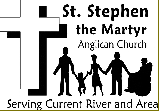Planning Worship
The basis for our worship in the Catholic tradition, which is the basis of the Anglican tradition, is the seasons and the lectionary. The lectionary is a schedule of readings from the Bible, which is a record of God’s activity with the people of Israel and of Jesus. The Bible is important to the church because it accepted as the Word of God and the church believes God continues to speak to people when we relate our own experience to these stories and sayings. The whole of the liturgy: hymns, prayers and sermon are based on the liturgical seasons and the lectionary.
The liturgical seasons are Advent, Christmas, After Epiphany, Lent, Holy Week, Easter, and After Pentecost. Advent causes us to reflect on the themes of the 2nd coming of Christ and the 1st coming of Christ. Christmas, which is 12 days from Christmas Day to Epiphany, helps us think about the incarnation of God, or God becoming a human being. Lent is a preparation for Easter, a time of penitence and takes as its inspiration the 40 days Jesus spent in the wilderness. Holy Week, from Palm Sunday to Holy Saturday, is a liturgical re-enactment of Jesus’ last week. Easter celebrates Jesus’ resurrection. Holy Week and Easter are the foundational events of the Christian faith in that they teach us about the defeat of sin, Satan and death and the new life through faith in Jesus. After Epiphany and After Pentecost are used to read books of the Bible “in course”, i.e., from beginning to end. In the Roman Catholic tradition these seasons are called ordinary time.
The lectionary is based on the seasons, in that scripture passages are selected to teach the stories and ideas associated with a season. The Revised Common Lectionary, used by most of the mainline churches, attempts to read most of the Bible over a 3-year cycle.
Sometimes there are other themes to consider, such as Mother’s Day. The pastoral situation of the parish is a consideration. The death of a parishioner, conflict in the parish, or a major national event such as a national disaster may need to be addressed.
Selecting Hymns and Prayers
To select the hymns and prayers, the scripture is first read. Then hymns are selected that fit with the particular scripture passage and season. Common Praise, the Anglican Hymn Book, has a Biblical index that lists scripture passages and suitable hymns for each passage, and a subject index.
Hymns are identified that are appropriate for particular liturgical actions. The first or processional hymn is often a hymn of praise, adoring God. The offertory hymn tries to pick up the idea of offering our whole self to God. It ought to be a longer hymn to cover the actions of collecting the offering and preparing the Lord’s Table. The last or recessional hymn is often a hymn of celebration, which encourages us to put our trust in God as we go into the world to minister in God’s name.
Finally, these hymns are identified basis on what is familiar to the congregation. The more well-known hymns are often put as the processional or recessional hymns. A difficulty in picking hymns is that some weeks the list of appropriate hymns that are familiar, is short. The hymns are picked to balance fitting with the themes of the day, and what is familiar to the congregation.
The Prayers of the People and the Eucharist Prayer are selected basis on the themes of the scripture and the season. Sometimes they are picked to emphasize the topic of the sermon; sometimes to pick up a theme which the sermon does not address.
It is such a pleasure when the Holy Spirit works, that different people who plan and participate in the liturgy: the Officiant, the preacher, the choir and the people, have a worship experience where all the elements fit together in an effective way.
See also:


